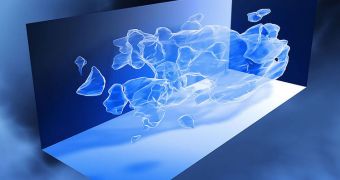For years, astronomers have been proposing that the Milky Way and other galaxies in the Local Group are being drawn towards a dark mass called the Great Attractor. New data from telescopes in Chile are showing that that may not be the case at all.
This mass was proposed to exist in order for experts to be able to account for the pull our galaxy is being subjected to. In addition to the Milky Way, tens of thousands of other galaxies appear to be heading towards a single point in space as well.
That point was proposed to exist some 250 million light-years away from our solar system. Galaxies are heading towards it at a speed of 22 million kilometers (14 million miles) per hour, and astronomers have no way of accounting for that motion other than to use the force of gravity.
As such, the attractor can only be a large volume of dark matter. But alternative theories say that this is not necessarily the case. The latest studies indicate that those theories are incorrect.
Investigators recently used a number of telescopes that the European Space Agency (ESA) operates in Chile, and put the dark attractor theory to the test. Previous calculations showed that the mass should be located between the Milky Way and Andromeda.
Calculations have also shown that it must have a mass at least 10 times that of our galaxy. Its existence may also explain why Andromeda is heading towards the Milky Way at more than 200,000 miles per hour, when our galaxy's gravitational pull is not nearly strong enough to cause this.
Still, the very existence of a dark attractor implies that dark energy and dark matter are not real, and that the Big Bang model of cosmology is entirely wrong. Theories explaining such attractors say that we are not living in a homogeneous Universe.
The homogeneity of the entire Cosmos is one of the basic tenants of the Big Bang model. However, the issue can be easily solved, by searching for temperature variations in the Cosmic Microwave Background (CMB), the relic radiation that was left over when the Universe was born.
If dark attractor theories were correct, then telescope should have discovered large temperature fluctuations in the CMB. The most advanced missions have yet to find the discrepancies needed to confirm those hypotheses.
In a new study by experts at the Fermi National Accelerator Laboratory (Fermilab), scientists show that telescope observations do not support alternative theories on the nature of the Universe. The work was conducted by expert Albert Stebbins.
He worked closely with Shanghai Astronomical Observatory expert Pengjie Zhang on this research, which is detailed in a paper appearing in the latest issue of the esteemed scientific journal Physical Review Letters, Daily Galaxy reports.
Until an improved theory is developed, the Universe continues to be made up of 70 percent dark energy, 25 percent dark matter, and only 5 percent normal matter, experts conclude.

 14 DAY TRIAL //
14 DAY TRIAL //